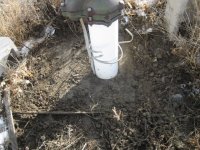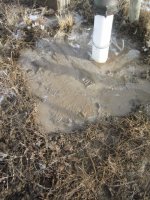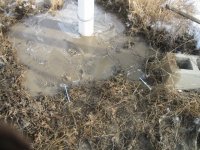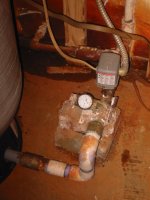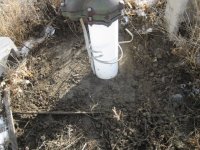Coloradogirl
New Member
The heater, where the pressure tank is located, failed during subzero weather. Here is the setup: If you are standing at the pitless well, the house is a couple hundred feet to the south and the shop that holds the fiberglass pressure tank is 60' +/- to the north of you. Prior to failure water ran in house with better than normal pressure - then later resumed typical lower pressure then stopped.
At the shop bathroom, where pressure tank is, I found the temp at about 20 to 30 - no running water and no apparent leaks from broken pipes (yet). I shut off well pump breaker and replaced and cranked up heater in the room.
Next day, turned on pump. Water to house fine - still no water at pressure tank. Checked later and found massive new pooled fresh and frozen water between well and shop area. No water leak at pressure tank area. Shut off pump breaker and waited another day. Next day - turned on well pump and found broken pipes to bath shower. Shut off connection to bath - no water leaks from pressure tank or associated pipes.
However, water was flowing up from well. Well head is embedded in pipe within pipe in a 2 x 2 cement slab with cast iron access head rising up 2'. Water "appears" to be flowing from the pipe within pipe area in the slab. I don't see any evidence (yet) that water is bubbling up from the ground area anywhere else, but we still have 8" or so of snow on ground - but temp is 45 today.
This is a submersible pump - the well is about 340' deep. The pump is operating and water is flowing to the house to the south of the well and the shop bath housing the pressure tank - and clearly is flowing out ground level at the well. When the pump breaker is off, the pressure tank shows 20/30 lbs pressure - shows about 60 when the breaker is on. Truthfully, it seems to me that the pressure tank typically shows 20/30 lbs when in use until the tank is pressuring up. I have about 13 hydrants to this system for pastures, pens and runs. All syphon freeze-free, although I don't see these as related to this issue.
I've some concerns regarding the well service guy and would like some help trouble shooting before I call anyone out. I'm still "defrosting" the system, more or less, but hope you guys can offer some ideas about what has happened. The area where the original freeze happened is 60 feet or more from the water flow from the well so I can't see it as a broken pipe from so far. All pipes are 3' or more down and water is flowing to each building when I turn on the well pump.
Is it possible that a pressure buildup from the frozen pipe broke a connection to the well or cracked the casing? Its just me here - so keep it simple.
At the shop bathroom, where pressure tank is, I found the temp at about 20 to 30 - no running water and no apparent leaks from broken pipes (yet). I shut off well pump breaker and replaced and cranked up heater in the room.
Next day, turned on pump. Water to house fine - still no water at pressure tank. Checked later and found massive new pooled fresh and frozen water between well and shop area. No water leak at pressure tank area. Shut off pump breaker and waited another day. Next day - turned on well pump and found broken pipes to bath shower. Shut off connection to bath - no water leaks from pressure tank or associated pipes.
However, water was flowing up from well. Well head is embedded in pipe within pipe in a 2 x 2 cement slab with cast iron access head rising up 2'. Water "appears" to be flowing from the pipe within pipe area in the slab. I don't see any evidence (yet) that water is bubbling up from the ground area anywhere else, but we still have 8" or so of snow on ground - but temp is 45 today.
This is a submersible pump - the well is about 340' deep. The pump is operating and water is flowing to the house to the south of the well and the shop bath housing the pressure tank - and clearly is flowing out ground level at the well. When the pump breaker is off, the pressure tank shows 20/30 lbs pressure - shows about 60 when the breaker is on. Truthfully, it seems to me that the pressure tank typically shows 20/30 lbs when in use until the tank is pressuring up. I have about 13 hydrants to this system for pastures, pens and runs. All syphon freeze-free, although I don't see these as related to this issue.
I've some concerns regarding the well service guy and would like some help trouble shooting before I call anyone out. I'm still "defrosting" the system, more or less, but hope you guys can offer some ideas about what has happened. The area where the original freeze happened is 60 feet or more from the water flow from the well so I can't see it as a broken pipe from so far. All pipes are 3' or more down and water is flowing to each building when I turn on the well pump.
Is it possible that a pressure buildup from the frozen pipe broke a connection to the well or cracked the casing? Its just me here - so keep it simple.

